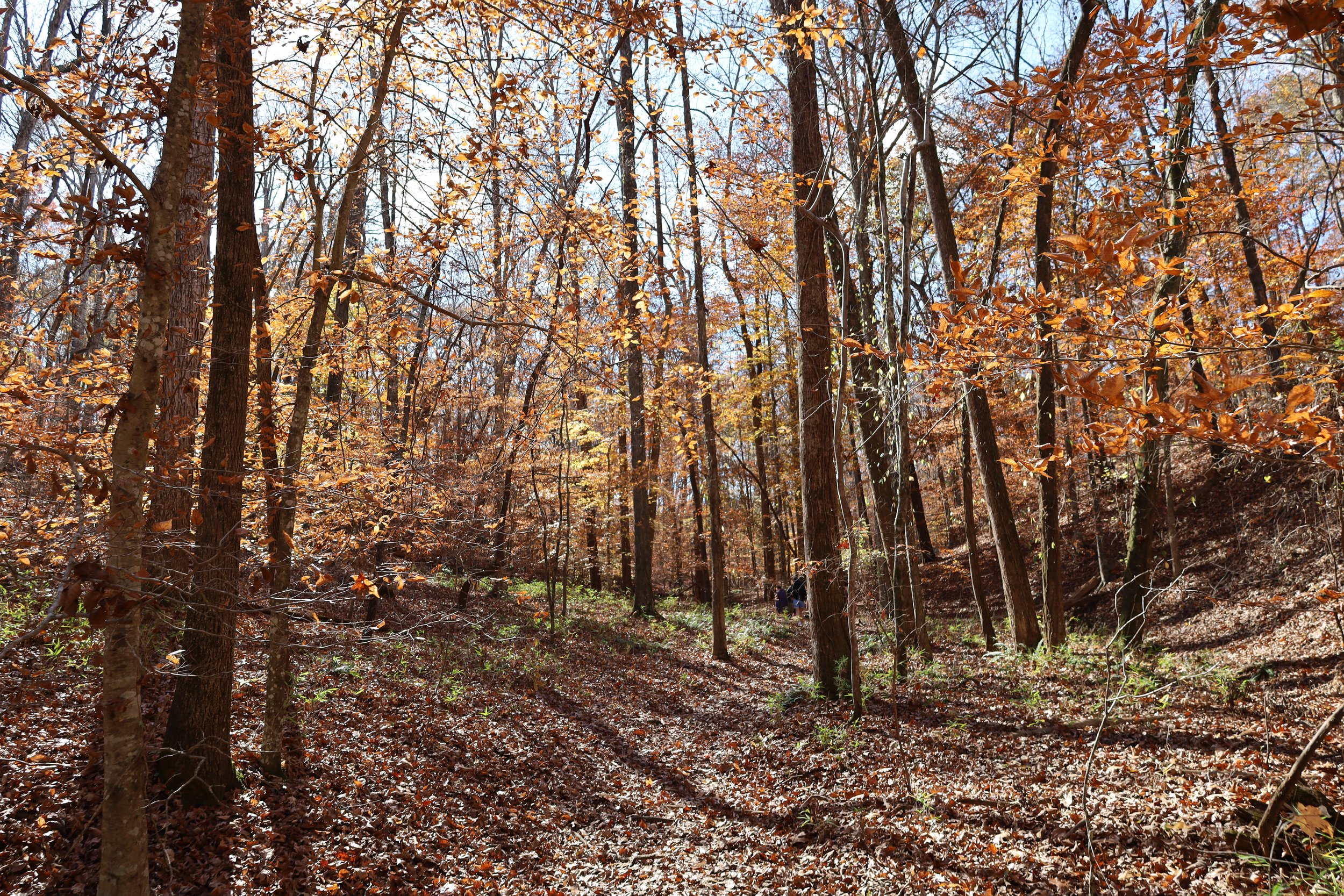
Carbon Sequestration
Anneewakee Forest Preserve
The Georgia-Alabama Land Trust Anneewakee Forest Preserve is a 185-acre forest in the Atlanta metropolitan area. The forest consists primarily of mature oak hickory trees. Anneewakee Creek flows through a quarter mile of the Preserve, and maple, elm, and beech trees dominate along the creek. The property is zoned low density residential in an area experiencing a high volume of suburban growth. Protecting the forest will preserve habitat, expand recreational opportunities, provide relief from the heat island effect of urban development, and promote watershed functions in the Greater Atlanta region.
Georgia-Alabama Land Trust will protect the forest long-term as a wildlife sanctuary, with passive walking trails for the public. Bird species afforded habitat include Kirtlands warbler, Bald Eagle, Swainson’s warbler, tufted titmouse, red-bellied woodpecker, red-shouldered hawk and scarlet tanager. The forest is also being considered as part of a master trail plan for Douglas County. Public trails in the Anneewakee forest will promote outdoor recreation opportunities for nearby neighborhoods and urban areas.
The following information and documents are made available to better understand the nature and scope of this project and to comply with the disclosure requirements of California’s Voluntary Carbon Market Business Regulation Act (Assembly Bill 1305).
We have reached our maximum amount of project partners at this time.
| Project Operator | Carbon Credit Project Name | Project Status | Project Type | Project Site Location | Protocol Version | Protocol Accrediation | Project Start Date | Project Timeline | Number of Credits Issued | Est. Number of Credits over Lifetime | Third Party Verified |
|---|---|---|---|---|---|---|---|---|---|---|---|
| Georgia-Alabama Land Trust | Anneewakee Forest Preserve | Validated, Verified, Credits Issued | Preservation | Oak Hill Rd, Douglas County, GA | City Forest Credits - February 2022, Version 11.40 | ICROA Endorsed | 12/8/2022 | 40 years | 8,598 | 31,814 | Yes |
| Carbon Quatification | |
|---|---|
| Project Area (acres) | 185 |
| Does carbon quantification use stratification (yes or no) | No |
| Percent tree canopy cover with Project Area | 100% |
| Project Stock (tCO2e) | 46,941 |
| Accounting Stock | 37,553 |
| On-site avoided biomass emissions (tCO2e) | 33,797 |
| On-site avoided soil carbon emissions (tCO2e) | 11,100 |
| Deduction for displaced biomass emissions (tCO2e) | 6,185 |
| Deduction for displaced soil emissions (tCO2e) | 3,363 |
| Credits from avoided biomass emissions (tCO2e) | 27,612 |
| Credits form avoided soil emissions (tCO2e) | 7,737 |
| Total credits from avoided biomass and soil emissions (tCO2e) | 35,349 |
| Credits attributed to the project (tCO2e), excluding future growth | 35,349 |
| Contribution to registry Reversal Pool Account | 3,353 |
| Total credits to be issued to the Project Operator (tCO2e) | 31,814 |
-
Total Credits Issued: 8,598
2023: 8,598 credits issued
Total Credits Sold: 1,100
2023: 1,100 credits sold
Total Credits Retired: 1,100
2023: 1,100 credits retired
Total Credits Cancelled: 0
Total Credits Available for Purchase: 7,498
-
Forest preservation projects not only reduce carbon dioxide from the atmosphere but also provide ecosystem services or co-benefits that can be quantified. The co-benefits from this project represent a savings (avoided costs) of $85,582 per year, and $3,423,291 over 40 years.
Rain interception (stormwater management) – 21,390.50 m3/year, $55,949 per year
Air quality – 4.8 tons/year, $11,587 per year
Energy – cooling (electricity) – 221,815 kWh/year, $16,836 per year
Energy – heating (natural gas) – 116,557 kBtu/year, $1,211 per year
-
The 17 United Nations Sustainable Development Goals (SDGs) are an urgent call for action and global partnership among all countries, representing key benchmarks for creating a better world and environment for everyone. Well-designed and managed urban forests make significant contributions to the environmental sustainability, economic viability and livability of cities.
The main SDGs for this project are described below, with more detailed information in the Project Design Document.
A resilient forest will ameliorate against the urban challenges, such as heat island effect and poor air quality. Walking trails throughout Anneewakee Forest will provide a place for exercise, grounding and connecting with nature.
The forest will slow the flow of stormwater, filter it, and provide a stable environment for aquatic plants and animals.
This project protects a mature forest that promotes biodiversity and wildlife habitat and increases ecosystem function.
-
GALT has no knowledge that the durability of the project’s greenhouse gas reductions or greenhouse gas removal enhancements is less than the atmospheric lifetime of carbon dioxide emissions.
-
The protocol provides for detailed accountability measures in the event the project is not completed or does not meet project emissions reductions or removal benefits. See Section 9 of the Protocol for information on reversals, avoided reversals, compensation for avoided reversals, unavoidable reversals, calculation of unavoidable reversals, and compensation for unavoidable reversals.
-
See Carbon Quantification, Additionality, and No Double Counting within the Project Design Document below. Also see Sections 5, 6, and 11 of the Protocol below.
-
-
-
Emissions reduced or carbon removed on an annual basis
| Project Name | Issuance Year | GHG Reductions and Removals atrributed to the Project (mtCO2e) | Reversal Pool Account (10%) (mtCO2e) | Emission Reductions to be Issued to Project (mtCO2e) |
|---|---|---|---|---|
| Anneewakee Forest Preserve | 2023 | 9,553 | 955 | 8,598 |
| Anneewakee Forest Preserve | 2024 | 9,553 | 955 | 8,598 |
| Anneewakee Forest Preserve | 2025 | 9,553 | 955 | 8,598 |
| Anneewakee Forest Preserve | 2026 | 6,690 | 670 | 6,020 |
| Cumulative | 35,349 | 3,535 | 31,814 |
